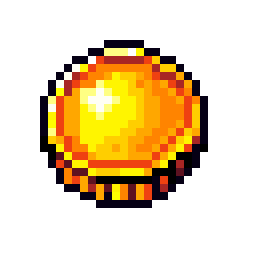Golden Treasure Chest Icon: Retro Game Reward
A golden, pixel art treasure chest gleams against a black backdrop, rendered in warm hues that evoke a classic fantasy reward. The isometric view and strategic highlights give the retro-styled chest a surprisingly three-dimensional feel, hinting at untold riches within.
Read More
The image depicts a single subject: a small, ornate pixel art treasure chest. The chest is shown in a slightly three-quarter isometric view, angled slightly to the right, presenting both its front face and a portion of its top and right side. Its posture is static, implying it is closed and at rest, awaiting discovery or interaction. The chest is centrally composed within the black void of the frame, occupying a significant portion of the vertical space while leaving ample black space around its perimeter. There is no discernible background or environment; the chest floats against a pure black canvas, isolating it as the sole focus.
The color palette is dominated by various shades of orange and yellow, creating a rich, metallic gold appearance. Specifically, colors range from a bright, almost white yellow (e.g., #FCE290, #E4B551) for highlights, through a warm goldenrod (e.g., #C68936, #A66C22), to deeper, more reddish-brown hues for shadows and outlining (e.g., #814F1D, #59391F). A deep reddish-brown (#412A18) is used for the darkest accents and outer edges. The overall color scheme is warm, vibrant, and highly saturated, effectively conveying the impression of polished gold despite the low resolution.
The overall vibe evoked by the image is one of potential discovery, reward, and classic fantasy adventure. It feels iconic and immediately recognizable as a staple object from countless video games. There's a subtle sense of anticipation associated with what might be contained within. Details include a distinct, darker band running horizontally across the middle, suggesting the chest's lid, and a prominent, lighter-colored lock mechanism on the front face, positioned slightly off-center to the left. The pixelated nature of the art gives it a nostalgic, retro aesthetic, reminiscent of 8-bit or 16-bit era graphics. The highlights are strategically placed to suggest curvature and reflectivity, particularly on the top and upper edges, giving the flat pixels a three-dimensional quality.
 25
25
